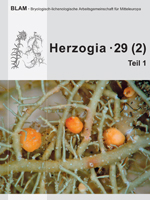Berg, C., Schwager, P., Pöltl, M. & Dengler, J. 2016. Plot sizes used for phytosociological sampling of bryophyte and lichen micro-communities. — Herzogia 29: 654–667.
To study the ecology of bryophytes and lichens, a plot-based approach in the tradition of phytosociology is widely used in Europe. Plot size has a crucial influence on the outcome of various analyses. Vegetation-environment analyses, biodiversity studies and vegetation classifications can be strongly biased if different plot sizes are compared or combined. For this reason, standard plot sizes have been recommended repeatedly. We collected 122 articles from eight international journals to analyse which plot sizes they used for sampling bryophyte and lichen communities. We found 11,573 relevés from 19 European countries, with German data and bryophyte communities being prevailing. Overall plot sizes ranged from 0.0002 to 30 m2. The medians of plots sizes of saxicolous, corticolous, terricolous and lignicolous communities were all in the range of 0.04 to 0.09 m2. Much smaller plots were used for bird casts and for epiphyllous micro-communities, with the smallest plots being only 2.1 cm2 in size. The largest plots exceeded 1m2 and were mostly used for terricolous lichen communities, in which most authors also recorded vascular plants. The most frequently used plot sizes in all data were 0.04, 0.01 and 0.03 m2, while differences between the substrate types and among the two taxa were of subordinate importance. To replace the former vague criteria used to determine the plot size, like minimum area, representativeness and homogeneity, we recommend the use of a standard plot size for future studies of cryptogam micro-communities. To achieve best-possible compatibility with former studies, 0.04m2 (20cm × 20 cm) appears as a good option. If cryptogam-rich vegetation types regularly cover many square metres or even hectares, we recommend to analyse them not only as micro-communities, but, including the co-occurring vascular plants and using plot sizes of 4–16 m2, also as part of the normal system of complete plant communities, where such types typically had been neglected. Finally, we emphasize the fundamental difference between complete phytocoenoses, which alone should be considered in conventional syntaxonomy, and partial communities (merocoenoses, synusia), which better should be treated in a parallel classification system with its own ranks. Plot size can be considered as strong circumstantial evidence, whether a record refers to a complete phytocoenosis or to a synusia. We recommend assuming for plot sizes below 1 m2 that they are either synusiae or incomplete records of phytocoenoses, thus in either case not suitable for conventional syntaxonomy. Syntaxa based on such micro-plots should generally be considered as invalid.





